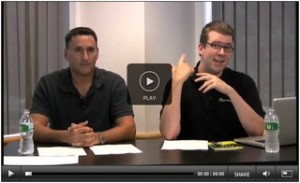 I have to say that this has probably been one of the most enjoyable years of my professional career. 2009 was my first full year running the Online Marketing functions at my company, Attivio. To say I learned a lot is an understatement. Most of my professional experience until 2009 centered around Software QA testing and engineering management. When I decided that I wanted to make the career change I wasn’t really worried, but there were many, many things I knew I had to learn. So yep, you guessed it, here’s my list of observations from the past year from the perspective of an R&D guy turned Online Marketer.
I have to say that this has probably been one of the most enjoyable years of my professional career. 2009 was my first full year running the Online Marketing functions at my company, Attivio. To say I learned a lot is an understatement. Most of my professional experience until 2009 centered around Software QA testing and engineering management. When I decided that I wanted to make the career change I wasn’t really worried, but there were many, many things I knew I had to learn. So yep, you guessed it, here’s my list of observations from the past year from the perspective of an R&D guy turned Online Marketer.
1. Don’t discount how much everyone thinks they know marketing, even though they don’t.
Messaging, collateral, graphics, web design, fonts (yes, even fonts) are seen by everyone in the company when it’s produced by the Marketing team. This is a lot different than say, some software code in a module in an application. No matter how awesome you think it is (or how hard you worked on it) be prepared for someone to NOT like it.
Takeaway: I’ve found that it’s necessary to be able to handle criticism, especially when it’s something you’ve built. That’s ok though, it’s better than not hearing any feedback at all (which can be worse).
2. Don’t wait.
Have wireframes? Send them to stakeholders for review.
Have mock-ups or draft copy? Send them to stakeholders for review.
Site updates on a staging server? Send them to stakeholders for review.
Takeaway: Nothing sucks more than hearing that something has to change because a stakeholder is seeing it for the first time right before you’re about to release, publish or send it out. If the CEO, CTO, CFO, C3PO need to review it before “it’s done”, then get them advanced previews early, even if it’s not the way things are typically done. It will save you time and headaches later. This is no different than in the engineering world, test early and often.
3. Inbound Marketing rocks, but don’t discount the power of Outbound too. It’s all part of the Marketing circle of life.
Face it, not everyone in the world knows about your company’s website. Even a kick-ass, highly-SEO-optimized site with great content isn’t going to be read by all your potential prospects. Outbound methods, coupled with optimized conversion pages on your site are really powerful.
Takeaway: Our most successful campaigns this year generated leads by using a multi-pronged approach of outbound (targeted emails with compelling calls-to-action to a purchased or home-built list) and inbound (a conversion page designed to compel the visitor to convert and thereby become a lead and even some SEM complimenting the whole thing). I still firmly believe that any lead you convert on your site (opt-in) is 1000 times more valuable than some name & email that’s bought off a list, but the magic is when you get that person to come to your site, connect with your content and then ask for more. My sales people LOVE the inbound leads and gathering more intelligence on them when they convert is one of my 2010 goals.
4. Video is powerful, video is cool, video is fun, but just another tool.
First off, let me say that producing video content is fun. It’s an avenue to be creative, to interact with people, to try to deliver content in new, compelling ways. However, it’s resource intensive if you want/need to produce high-quality production styles. Consult an expert. That being said, I’ve received more positive feedback on the video content on our site than anything else. Sometimes there are just concepts and ideas that aren’t easily conveyed in writing or with clever graphics. Video simply helps provide people another way grasp ideas, concepts or messaging.
Takeaway: Know your boundaries. If you’re producing video for a blog, don’t sweat the production quality. If it’s an intro video on your company homepage, it should be of the same quality as your homepage graphics/theme. Also, don’t be afraid, pick up a Flip or a Kodak Zi8 and start shooting content, the quality gets better as you learn what works and doesn’t. I would say 50% of the video I shoot is only used internally (Sales training and enablement), but may be the most valuable.
Takeaway #2: Buy external flash drives. Digitized video takes up gobs of space and you’ll quickly have a mountain of hours and hours of content that you’ll be sitting on.
Takeaway #3: Be prepared to invest some time. Planning, shooting, post-production, reviews can quickly suck up ALL of your time which, depending on many resources you have, can kill other objectives if your not careful.
5. Measure & course correct.
Are you tracking:
- site visitors over time?
- lead conversions across campaigns (inbound and outbound)?
- what happens to a lead once it’s given to your Sales team?
- the effectiveness of your SEM strategy?
- the content on your site that performs well (and poorly)?
- the latest trends/tools (there’s more than just Twitter)?
- how well your message is conveyed on your site?
- what your competitors are doing?
Takeaway: You should be. Understanding what works and doesn’t and being able to try different approaches in an agile manner is key to the role of an Online Marketer. Data analytics is your friend and can help support budget or kill ideas you know or feel are misdirected. There are many tools out there for all of the above. Research them and use them. It will make your life easier.
Happy New Year and thanks for reading. One of my resolutions is to post more in 2010 too.
Filed under: Marketing, Online Marketing | 2 Comments »


 I have to say that this has probably been one of the most enjoyable years of my professional career. 2009 was my first full year running the Online Marketing functions at my company, Attivio. To say I learned a lot is an understatement. Most of my professional experience until 2009 centered around Software QA testing and engineering management. When I decided that I wanted to make the career change I wasn’t really worried, but there were many, many things I knew I had to learn. So yep, you guessed it, here’s my list of observations from the past year from the perspective of an R&D guy turned Online Marketer.
I have to say that this has probably been one of the most enjoyable years of my professional career. 2009 was my first full year running the Online Marketing functions at my company, Attivio. To say I learned a lot is an understatement. Most of my professional experience until 2009 centered around Software QA testing and engineering management. When I decided that I wanted to make the career change I wasn’t really worried, but there were many, many things I knew I had to learn. So yep, you guessed it, here’s my list of observations from the past year from the perspective of an R&D guy turned Online Marketer.


